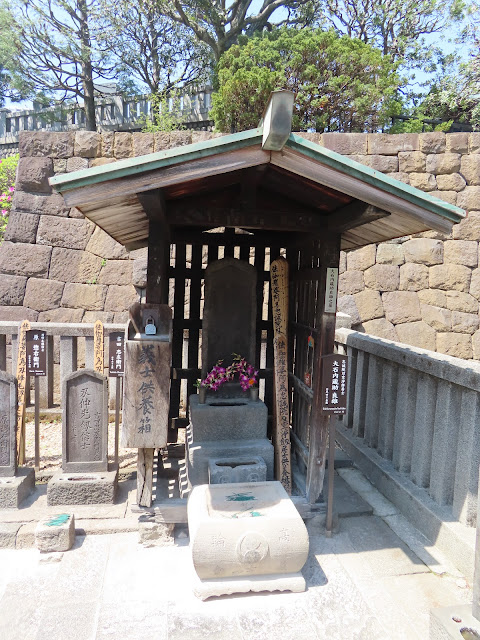Monday, April 15, 2024
Sengaku-ji Temple is a Zen Buddhist temple. The legendary Forty-seven Rōnin are buried here. (Rōnin are leaderless samurai.) The true story of the Forty-seven Rōnin is also known as The Akō Incident or The Akō Vendetta.
On January 31, 1703 a daimyō, or feudal lord, performed seppuku, or ritual suicide after being commanded to do so by a court.
Here is what led up to this gruesome sentence:
A high court official named Kira had repeatedly mocked and insulted a daimyō known as Asano Naganori. Kira was an insolent, rude bully, and nobody liked him. Asano finally couldn’t take it any more, but he was in a bind. His honor demanded that he put a stop to Kira’s bullying, but Asano surely knew he would face execution or a sentence of seppuku because the Shogun had outlawed such vendettas.
Ultimately, Asano assaulted Kira in what may have been a failed murder attempt. Asano was arrested, tried and ordered to kill himself with his sword. This was considered an honorable death.
Asano asked his samurai to avenge his death and asked the priests at Sengaku-ji Temple to bury him on the temple grounds. With Asano dead, his samurai became rōnin, but they remained loyal to Asano.
The rōnin planned, for over a year, to avenge their master’s death by killing Kira. The rōnin knew they would also be executed for carrying out their plot, but their loyalty to their master did not permit them to ignore his last request. The rōnin succeeded in capturing Kira and beheading him. They placed the head on Asano’s grave at Sengaku-ji Temple, gave all their money to the priests there, and asked the priests to see that they got a decent burial. Then they turned themselves in to the authorities and they were all sentenced to commit seppuku. They were buried next to their master, Asano, at Sengaku-ji Temple.
Today, people from all over the world come to see the site of the burial of Asano and the 47 samurai/rōnin. Their story has been told and re-told for 300 years now. It is well-known throughout Japan. It has been the subject of books, plays, films, paintings, and even an opera. It is entrenched in Japanese culture.
You can visit all the graves, and see the name and age of each person buried in each grave. The youngest was 16 years old. In fact, we were very strongly “encouraged” to purchase a bundle of incense and leave one or two sticks at each grave to send a message to each of the rōnin. If you go on December 14 you will see festival commemorating the incident.
I have been thinking a lot about this story. I am fascinated by it. What is it about the story that has made it so popular in Japan, and even in the west? What does the story say about Japanese culture? What can we learn from it today? Are we supposed to admire those involved?
I’m not sure what it means. To me it is a brutal, gruesome tragedy - a waste of many lives because of some misguided idea of honor and loyalty. That’s what I see when look at it through an American, female lens. Based on Wikipedia and This article, I think the Japanese see it as a story about national identity, about the glory days of the samurai, about loyalty and courage. I don’t think it is seen as a tragedy here in Japan, but as a source of pride.
If I stop taking it at face value and start thinking about it as an allegory, it suddenly changes into a cautionary tale for us today. It says if you let a perceived injury fester, it can turn into a spiral of violence. It asks what is the point of blind loyalty?
What does it say about our ability to obtain peace in the middle east? What does it say about what is happening in Washington right now? Speaker Johnson seems to be Asano and Marjorie Taylor Green is obviously Kira. Who is the shogun? Who are the 47? Who is going to be remembered in 300 years?
So, you might ask, “Why did I go to Sengaku-ji?” Honestly, I thought I was going to a temple. I had no idea I was going to see 48 graves. In fact, they didn’t even allow us to enter the temple.
Here are a few photos:
 |
| The main gate to.Sengaku-ji |
 |
| The entrance to the temple - the crest of the temple can be seen. |
 |
| Some pre-schoolers visit the temple grounds |
 |
| I think this was Asano’s grave |
 |
| I am placing burning incense in front of one of the rōnin graves |
 |
| Several ro0nin graves |
From this depressing and slightly creepy place, we walked for about 15 or 20 minutes to our next destination, a garden. Interesting things were spotted along the way.
 |
| Cars are moved into and out of stacked parking spaces usinng this turntable |
 |
| The road was very steep |
 |
| A tiny roadside shrine |
 |
| Meiji Gakuin University |
Happo-en Garden turned out to be more of an event venue than a garden, but it was a pleasant place.We had lunch in the main building and then we wandered around the garden. It was surprising to find such a large wooded tract in the middle of the city.
 |
| Azaleas are just starting to appear now! |
The garden had an interesting collection of the most delightful bonsai - some of them were 500 years old.
We went to a tempura place for dinner. (I’ll find the name and add it later.) It was good, but no more than that. 3 out of 5.
Today’s fabric is a traditional Japanese pattern called sayagata. It is a pattern that represents life and strength. It is a design of interlocking swastikas. That sounds terrible, but this does not refer to the Nazis in any way. This is an ancient Buddhist symbol. The Nazis appropriated the Buddhist symbol and turned it around in reverse when they began to use it.














Very, very, interesting, Peggy…..
ReplyDeleteFrom Shirley Radder who you met on lax to Sydney cruise
ReplyDeleteThanks for all the info, and especially for your thoughts, Peggy. I guess maybe the ronin are emblematic of the ever-present human question of what’s worth dying for.
ReplyDeleteStill… as a feminist I can’t help but ask, “Where are the women and girls?” Perhaps the warriors were not allowed to have wives or children. Still… a central societal story where women have no part is going to always be problematic for me. Of course, the same is true of the central stories of many societies, including ours.